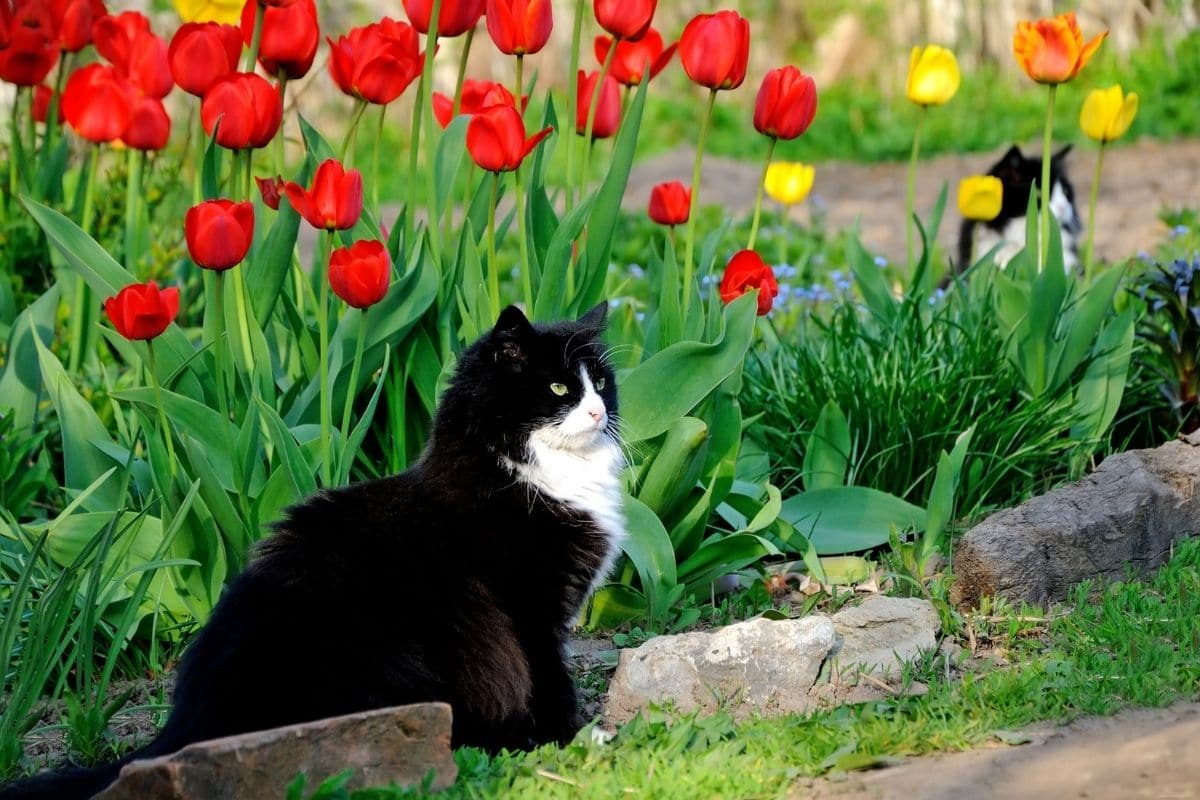Tulips (Tulipa) are among the first harbingers of spring and spice up not only the still gray garden, but also the apartment as cut flowers. Especially the latter can become a problem for cat lovers. Are tulips poisonous for cats?
To the point
- Tulips are considered highly toxic to cats
- All parts of the plant are affected
- Especially endangered are indoor cats and kittens
- Danger for outdoor cats somewhat lower
Contents
Poisonous or not?
As soon as the cold season is over, flower bulbs are offered everywhere, including tulips. They impress both in the bed and in the vase. But for cat lovers and especially their animals, these colorful messengers of spring are anything but good, because they are highly toxic.
You can’t always rely on cats’ instincts, because curiosity and play instinct often prevail. Then they like to nibble on plants, unfortunately also on poisonous ones. This is partly due to a lack of alternatives of suitable green food. Endangered are especially animals that are kept exclusively in the apartment and young animals, so-called kittens. A pretty bouquet of tulips can thus quickly become the cause of poisoning. The situation is different with free-rangers, they have the possibility to eat grass and are rather less interested in tulips.
Poisonous plant parts
All parts of the tulip are poisonous to cats, i.e. leaves, flowers, stems and bulbs, with bulbs and stems said to be particularly toxic. The poisonous effect is due to the toxin tulipanin. The toxins it contains can act both internally and externally. Most often, poisoning occurs in cats through oral ingestion.
Tip: A poisonous effect that should not be underestimated also comes from the flower water. This can be the water in the flower vase in which the tulips stand or excess watering water in the coasters of potted tulips.
Symptoms of poisoning
If tulips became a victim of the cat, it does not necessarily entail poisoning. It is best to take a closer look at the tulips first. If parts of the plants are missing, it is relatively likely that the cat has eaten them. There is also an increased risk if your cat only chews on part of the plant.
- smallest amounts of plant material are enough for poisoning
- even the mere contact with pollen of the tulip
- Poison gets onto the cat’s fur
- and through licking or cleaning into the body
- triggers there partly violent reactions
- if poisoning is suspected, observe the animal well
- to recognize possible symptoms early
The first sign of poisoning is usually vomiting. Other signs of poisoning may include salivation, diarrhea, dilated pupils, accelerated breathing and problems with coordination (staggering). If the animal suffers from pre-existing liver or kidney conditions, the potential for danger is even greater, as the toxins cannot be transported out of the body in the normal way.
Quick help
The first thing to do is to check the cat’s mouth for plant debris and, if present, remove it as best you can. Throwing them away is not a good idea, it is best to take them in a small bag to the vet. The vet should be visited as soon as possible. The faster the animal is presented to a doctor, the faster it can be helped and the better the chances of recovery. Especially when it comes to larger amounts of consumed plant material, time is of the essence, because the cat can suffer serious organ damage or even die in the worst case.

Prevent poisoning
Poisoning from tulips cannot be completely prevented, but precautions can be taken, especially indoors, to keep the risks as low as possible. Of course, the easiest thing to do would be to avoid tulips and generally all plants in the home and garden that are poisonous to pets. But not everyone can or wants to do that. But then you should put such plants in a place inaccessible to cats, which is not so easy with cats
Tip: Petals falling unnoticed and, as already mentioned, the flower water in the sink also pose a great danger.
Frequently asked questions
Why do cats eat plants in the first place?
Eating grass is a natural need of these animals. The free-rangers among them eat grass to get the hairs swallowed during grooming out of their bodies again. They are then regurgitated again and again. The grass acts practically as a natural emetic. The apartment cat does not have this possibility and helps itself with indoor plants, it has no other choice.
Can apartment cats be offered an alternative?
To protect the cat and the houseplants, it is advisable to offer it a pot of cat grass. This can be purchased at a garden center or you can sow it yourself. Unfortunately, this does not appeal to every cat. Then you can try planting a piece of turf in a pot of soil and offering that to her. This is especially good for cats that can use a balcony.
Is it advisable to make the cat vomit in case of poisoning?
No, absolutely not. Vomiting causes the poison to pass through the mucous membranes of the esophagus one more time, bringing it into contact with the toxic substances again and further aggravating the symptoms.

